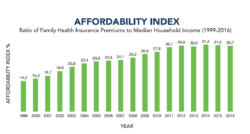November 2, 2017

Introducing the Healthcare Affordability Index: High-Cost Private Health Insurance Reduces Family Incomes
Today, Dr. Ezekiel Emanuel and I along with Aaron Glickman published Measuring the Burden of Health Care Costs on U.S. Families in the Journal of the American Medical Association (JAMA). The article introduces the Healthcare Affordability Index (Index)[1], a simple and powerful metric for assessing the impact of rising healthcare cost on American living standards.
The Index measures the relationship between the total cost (employer plus employee contributions) of a private family health insurance policy and median household income. Importantly, the Index reveals this obvious but hidden truth: the very high cost of private health insurance contributes significantly to middle-class wage stagnation.
More than half of Americans depend on employer-sponsored health insurance for their healthcare. As health care costs rise, health insurance premiums also rise. This requires both employers and employees to pay more for healthcare coverage, reducing workers’ take-home pay.
Employer-sponsored health insurance subsidizes America’s inefficient and exceptionally high-cost healthcare delivery system. In other words, high-cost healthcare could not exist without very high-cost private health insurance.
Instability in Obamacare’s health exchanges has brought the issue of exploding health insurance prices to the public’s attention. Commercial health insurance companies are exiting public exchanges in droves. Those that remain are imposing double-digit premium increases. High-prices and high deductibles are making health insurance unaffordable for many who need it.
Educating Americans on the direct connection between healthcare expenditures and the all-in costs of health insurance has become a priority. The timing could not be better for inaugurating the Healthcare Affordability Index.

Computing the Healthcare Affordability Index
Since 1999, the Kaiser Family Foundation has published an annual survey of employer health benefits. Employer-sponsored health insurance covers approximately 178 million Americans, largely through private commercial health insurance plans.
The Census Bureau has tracked nominal and real median household incomes since 1984. It is a widely-used measure of middle-class incomes. On an inflation-adjusted basis, median U.S. household incomes peaked in 1999 and have stagnated since. Median U.S. household income in 2016, the latest year reported, was $59,039.
Measuring the numerical relationship between these credible, widely-available metrics creates a framework for assessing the financial burden imposed by health insurance on middle-income families. The chart below measures healthcare affordability between 1999 and 2016 through the Healthcare Affordability Index.

Here are several salient observations regarding the Healthcare Affordability Index:
- The ratio of health insurance premiums to median household income has more than doubled from 14.2% to 30.7% in less than 20 years.
- Increasing health insurance costs exert a substantial and depressing influence on wage growth. Health insurance premiums increased 4.7 times faster (213% vs. 45%) than workers’ earnings between 1999 and 2016.
- All other things being equal, a constant 14.2% Healthcare Affordability Index would translate into a 2016 median household income of $68,780, which is a meaningful $9,741 (16.49 %) increase over the current level of $59,039.
- As noted in the JAMA article, a companion Comprehensive Healthcare Affordability Index adds deductibles and co-pays to the calculation shows that Americans’ out-of-pocket costs for healthcare go way beyond the premium, consuming over 33% of 2015 median household income.
- The Index has hovered around 31% since 2012. This may indicate a natural barrier against further increases.
- Analysts can calculate the Index at state and regional levels as well as the national level. This enables assessment of relative healthcare affordability across geographies.

Consumers Disconnected from Rising Healthcare Costs
Americans understand that healthcare is expensive, but generally do not recognize the direct connection between health insurance premiums, healthcare costs and their income. The following factors contribute to this perception failure and blunt optimal consumer purchasing behavior:
- Employers and governments cover the lion’s share of health insurance costs. This benefit insulates consumers from actual healthcare expenditures. Americans worry more about access to healthcare services than their cost.
- Consumers experience the healthcare marketplace through the purchase and use of health insurance products. Their relevant measures are not healthcare costs, but rather the costs of insuring against adverse health expenditure (employee health insurance premiums, deductibles and co-pays).
- Healthcare principals negotiate prices without customers. Patients see doctors who prescribe treatments for which a third-party (e.g., a health insurance company) pays a pre-determined price. This transaction process severs the buyer-seller relationship that governs transactions between consenting parties in efficient markets.
- Employees focus on income, while employers focus on total compensation. Consequently, workers under-appreciate the negative impact rising healthcare and health insurance costs exert on their take-home pay.

Public Policy Implications
Increasing healthcare and related employer-sponsored health insurance costs exert a double whammy on wages. Workers pay more for health insurance, decreasing out-of-pocket spending. Meanwhile, escalating health insurance costs limit employers’ ability to increase wages. The net result: workers pay more for health insurance and receive lower pay.
Healthcare costs are strangling middle-class incomes. “We the People” fund America’s bloated healthcare system and its costs fall disproportionately on low- and middle-income Americans through wage stagnation and declining health status. This negative cost-shift deprives American workers of vitally needed income.
Funding America’s highly expensive, inefficient and often ineffective healthcare delivery system through high-cost private health insurance plans has consequences. It weakens the American economy. It reduces the global competitiveness of U.S. companies. It robs workers of higher wages and lowers living standards. It also siphons investment from more productive industries.
The Healthcare Affordability Index connects the high cost of private health insurance with household incomes through a clear, easy-to-understand metric. Properly appreciated, the ever-rising Index scores since 1999 should anger the American people. Properly informed, government officials could use their “bully pulpits” to advocate for lower Index scores.
Regular publication of the Index could stimulate industry-wide efforts to improve healthcare productivity and reduce costs. Concurrently, it would make individual providers, payers and suppliers more accountable as regions compete to offer more affordable healthcare services.
At a macro level, delivering the same or better healthcare for less money will free up enormous resources to pay workers higher incomes and invest in more-productive industries. The human and financial costs of U.S. healthcare’s fragmentation, dysfunction and unfairly distributed burden are massive. Fixing the system is this generation’s primary public policy challenge.
[1] Also termed the “Emanuel-Johnson Healthcare Affordability Index”





